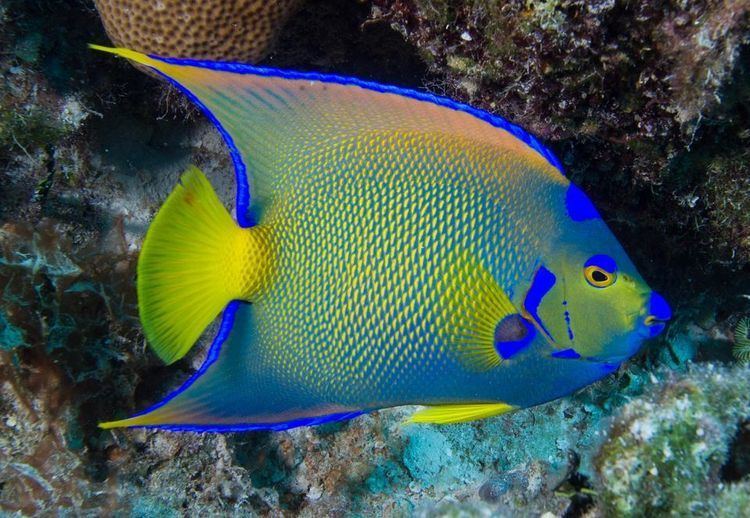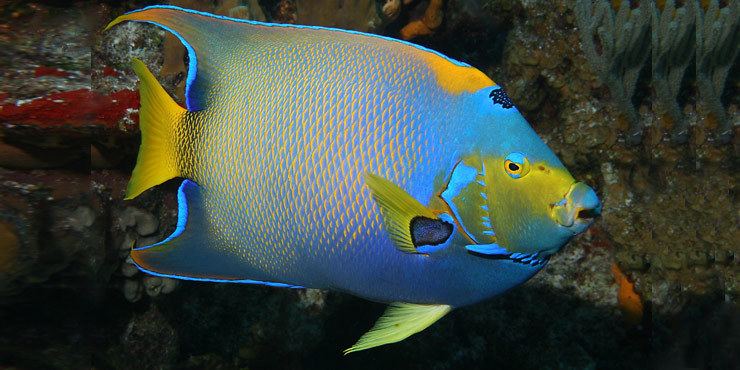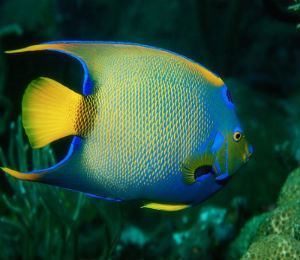Order Perciformes Rank Species | Phylum Chordata Scientific name Holacanthus ciliaris Higher classification Holacanthus | |
 | ||
Similar Holacanthus, French angelfish, Bermuda blue angelfish, Emperor angelfish, Pomacanthidae | ||
Queen angelfish holocanthus ciliaris aquariumdomain com
The queen angelfish (Holacanthus ciliaris) is an angelfish commonly found near reefs in the warmer sections of the western Atlantic Ocean. Other common names include blue angelfish, golden angelfish, queen angel, and yellow angelfish. Holocanthus ciliaris should not be confused with Holocanthus bermudensis, or the (Bermuda) blue angelfish, despite very similar appearances. They are two separate species.
Contents
- Queen angelfish holocanthus ciliaris aquariumdomain com
- 240 gallons wow adult queen angelfish with purple lips and chin
- Description
- Diet
- Distribution
- Reproduction
- In aquaria
- References
240 gallons wow adult queen angelfish with purple lips and chin
Description

The adult queen angelfish overall body color can be described as blue to blue-green with yellow rims on its scales. Their pectoral and ventral fins are also yellow but their lips and the edges of their dorsal fins and anal fins are dark blue. Queen angelfish are also known to have blue markings around each gill cover. Juveniles have dark blue bodies with yellow lips, gills, and tail and vertical bars ranging in color from light blue to white. The colors of the juvenile fish help them to blend in with the reefs. The queen angelfish may live up to 15 years in the wild and reach up to 45 centimeters (17 inches) in length. Queen angelfish are about three and a half pounds.
Diet

The queen angelfish feeds primarily on sponges, but also feeds on tunicates, jellyfish, and corals as well as plankton and algae. Juveniles serve as "cleaners" and feed on the parasites of larger fish at cleaning stations. Although in home aquariums, aquarists have been successful in providing the queen angelfish a diet of meaty and algae based foods.
Distribution
Queen angelfish inhabit reefs and are common near Florida, especially the Florida Keys, and also the Bahamas and the Gulf of Mexico. It is rarely seen in the Bermuda Triangle and ranges as far south as Brazil and as North as Long Island.
Reproduction
The adults are found in pairs year round, perhaps suggesting a long-term monogamous bond. The pairs reproduce by rising up in the water, bringing their bellies close together, and release clouds of sperm and eggs. The female can release anywhere from 25 to 75 thousand eggs each evening and as many as ten million eggs during each spawning cycle. The eggs are transparent, buoyant, and pelagic, floating in the water column. They hatch after 15 to 20 hours into larvae that lack effective eyes, fins, or even a gut. The large yolk sac is absorbed after 48 hours, during which time the larvae develop normal characteristics of free swimming fish. Larvae are found in the water column and feed on plankton. The larvae grow rapidly and about 3–4 weeks after hatching the 15–20 millimetres (0.6–0.8 in) long juvenile settles on the bottom.
In aquaria
The queen angelfish is considered to be moderate in difficulty to keep in captivity and is ill-suited for the inexperienced aquarist. They are a moderately aggressive species that require a large aquarium. Most aquarists recommend a minimum tank size anywhere from 150 on up to 180 gallons. The queen angelfish may harass other fish, particularly similar sized angelfishes. It should be the last fish added to any system. It is not a reef safe fish, and larger specimens may nip at corals, particularly stony or soft ones, and ornamental invertebrates.
